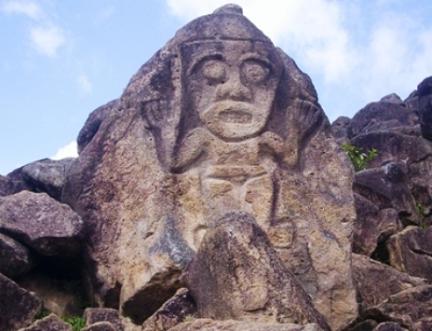Judi Lynn
Judi Lynn's JournalRacing To Save Mexico City's Floating Gardens
Racing To Save Mexico City's Floating Gardens
Unchecked urbanization is destroying what's left of the Mexican capital's pre-Aztec chinampas.
Frédéric Saliba (2015-05-31)

[font size=1]
Chinampas in Xochimilco
[/font]
MEXICO CITY — Pelicans glide in arrow formation over the lake at Xochimilco, south of Mexico City, as two elegant herons stand in the water and stare at a boatload of tourists. Extending across 7,500 hectares of canals and gardens, this bucolic landscape displays a range of greens almost unimaginable, all in sharp contrast to the smog and frenzy of the Mexican capital right next door.
The lake is the setting of chinampas, the floating vegetable gardens developed here more than 500 years ago. They are one of the last remaining features of the ancient Aztec capital of Mexico-Tenochtitlán, conquered by Spaniards in 1521.
Five centuries on, this network of waterways and artificial islands, a UNESCO World Heritage Site, is threatened by the city's disorderly expansion and over-exploitation of its water resources. The government of Mexico City has an action plan, financed by France, to save this enormous district of the capital that is also the home of ancestral farming traditions and exceptional biodiversity.
"There is no time to lose," says resident Claudia Zenteno, pointing with clear frustration at plastic bottles, bags and cans floating in the dark, stagnant water outside her house.
More:
http://www.worldcrunch.com/rss/culture-society/racing-to-save-mexico-city-039-s-floating-gardens/xochimilco-lake-sewage-mexico-climate-change/c3s18554/#.VWtrvGdFDmQ
San Agustin and the mythical story behind its ancient statues
San Agustin and the mythical story behind its ancient statues
Posted by Torkan Omari on May 31, 2015
Around a little southwest Colombian town called San Agustin lay archaeological remains that tell stories of Gods, masters, and ordinary people belonging to a culture that flourished between the 8th and the 1st century BC.
A UNESCO world heritage since 1995, San Agustin presents the largest group of religious monuments and megalithic sculptures in South America.
Although a park has been created around the monuments, it is rather a collection of ceremonial and burial sites scattered over an area of 250 square miles, and are centered around three areas close to the town: the San Agustin plateaus, the Idols Hill, and the Stones Hill.
The archaeological landscape hosts sculptures ranging from 20 centimeters to seven meters, from abstract to realist art. The sculptures resemble human figures with threatening, smiling, or somber faces. But also rather divine creatures, warriors armed with clubs, round eyes or jaguars’ teeth of mythical heroes. Some seem to depict serenity and wisdom, others fear and darkness.
More:
http://colombiareports.com/colombias-san-agustin-and-the-mythical-story-behind-ancient-statues/
[center] 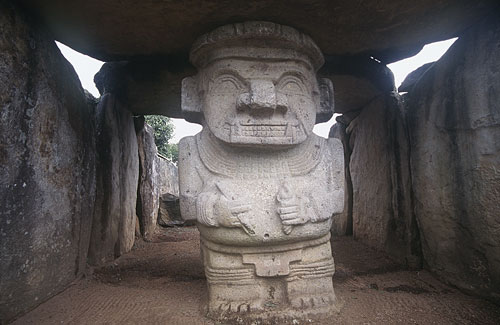



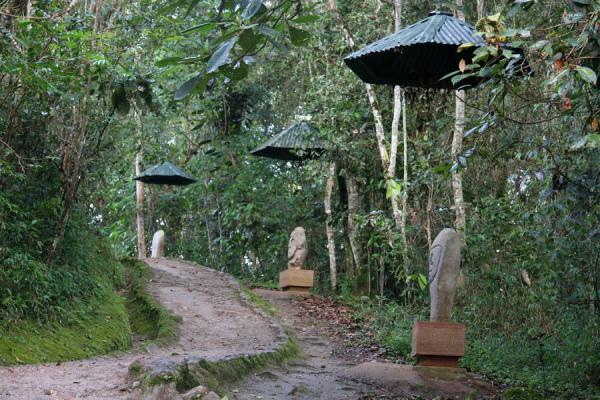

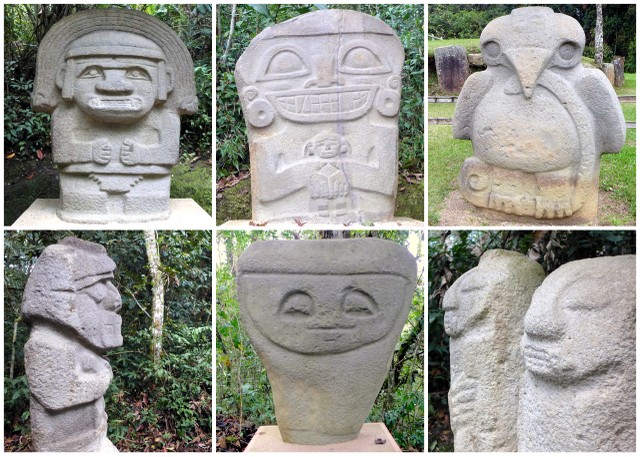




San Agustin Archaeological Park
More:
http://www.4gress.com/sights/entry/100289.html[/center]
More from google images:
https://www.google.com/search?sourceid=navclient&ie=UTF-8&rlz=1T4TSND_enUS566US566&q=stone+statues+of+san+agustin+colombia&tbm=isch&gws_rd=ssl#imgrc=_
Anthropology:
http://www.democraticunderground.com/12292112
A True Story About Big Sugar and Political Corruption in South Florida:The Strange Suicide of Art Te
May 28, 2015
A True Story About Big Sugar and Political Corruption in South Florida
The Strange Suicide of Art Teele
by ALAN FARAGO
In the accompanying picture, that’s me on the left. The year is possibly 1994. I’m standing next to the late Congressman William Lehman from Miami-Dade. Bill Lehman died in 2005. Next to Bill is the civil rights activist and Miami path breaker, Thelma Gibson. The sturdy, imposing African-American to the right was the star of the photograph. Arthur E. Teele Jr. (Sorry, I don’t recall the name of the woman to Art Teele’s left.)

[font size=1]
From left, Alan Farago, Rep. William Lehman, Thelma Gibson, Arthur E. Teele Jr. and an
unidentified woman.
[/font]
At the time, Art Teele was chair of the Miami-Dade County Commission. He died in 2005, too. A decade ago. A decade after this photo was taken. Twenty years after this photograph more or less, Arthur E. Teele blew his brains out in the lobby of One Herald Plaza, the home of the Miami Herald that also no longer exists. He did it for a reason: he believed he was being hounded out of existence by enemies including the powerful Herald.
In the photograph, Art Teele is caught looking off to the side. Bill Lehman is looking down. That happens, especially when photos are staged and there’s a lot going on around you. The moment the camera clicks you are inattentive. But as I look at the photo today, I recall Art Teele often looked that way when you were talking with him. Looking somewhere else. Restless.
Art had a powerful mind directed to politics. During an era when very few African-American Republicans rose to the top – Teele had been an Assistant Secretary of Transportation under President Reagan – he stood out. When the photo was taken and Teele was running for mayor of the Miami-Dade County Commission, I was his link to a constituency Art believed key: the Anglo vote in Florida’s most politically influential county. It was Art’s belief that a strong African-American turnout at the polls, connected with Anglo voters, could overcome the Cuban American bloc vote.
Local elections are non-partisan. Still, Art – a moderate Republican (extinct, too) – ran a single television ad during the 1996 campaign against Alex Penelas: it was a spot featuring Teele’s endorsement by the Sierra Club for his willingness to be a friend of the Everglades.
More:
http://www.counterpunch.org/2015/05/28/the-strange-suicide-of-art-teele/
US Military Presence In Central America Could Spark Atrocities, Warns Paper
Source: Bernama (Malaysia)
US Military Presence In Central America Could Spark Atrocities, Warns Paper
MEXICO, May 28 (BERNAMA-NNN-PRENSA LATINA) -- The new deployment of US troops in Central America will open another cycle of mass violations of human rights and atrocities in the region, Mexican daily newspaper La Jornada warned Thursday.
In an article, La Jornada says that in previous years, the deployment of US soldiers in the area had meant an increase in violations committed by the military forces led, trained and funded by the Pentagon and the CIA.
"The presence of the US military contingents have been translated into massacres, mass human rights violations, backing of tyrants and the loss of sovereignty in the affected nations," said the journal.
La Jornada recalled that many military incursions ended up in occupations or in the formation of "puppet regimes" in Nicaragua, Guatemala and Honduras.
Read more: http://www.bernama.com/bernama/v8/wn/newsworld.php?id=1138998
Some in congress working to curtail Obama’s advances on Cuba
Some in congress working to curtail Obama’s advances on Cuba
Sarah Stephens • May 23, 2015
WASHINGTON, D.C. – Step-by-step, legislation is working its way through Congress to curtail much of the progress President Obama is making in U.S.-Cuba relations by cutting the funds needed by federal agencies to implement his new policies.
We ask: Will those who benefit most from the new policies that encourage travel and trade with Cuba do nothing but stand on the sidelines in the expectation that President Obama will veto the bills that reverse them?
In 2011, after President Obama reinstated the rules allowing Cuban Americans to visit their relatives on the island and permitting all Americans to send remittances to Cubans, hardliners used the budget process to prevent the policies from being implemented.
Back then, the White House issued a policy statement promising to veto the legislation unless the budget riders on Cuba were removed. The President’s supporters, who comprised the majority in the Senate, kept the provisions out of the big budget bills that finally emerged from paralysis and delays on Capitol Hill. Legislation reversing the modest but hopeful travel and remittance reforms never reached the President’s desk.
More:
http://progresoweekly.us/some-in-congress-working-to-curtail-obamas-advances-on-cuba/
The Guatemala Experiments
The Guatemala Experiments
In the late 1940s, a group of doctors and researchers traveled to Guatemala and conducted extensive and often ghastly STD experiments there. This is the story behind who was responsible, what the test subjects did and didn’t know, and the onerous task of meting out justice.
Mike Mariani · 5 hours ago
On April 1, close to 800 plaintiffs filed a $1 billion suit in Baltimore City Circuit Court that alleges that, in the 1940s and ’50s, doctors and medical researchers from Johns Hopkins University played a substantial role in experimenting on hundreds of Guatemalans, inoculating them with sexually transmitted diseases—including gonorrhea, syphilis, and chancroid—and using various methods to transmit the diseases to their subjects.
The lawsuit specifically alleges that, between 1945 and 1956, physicians and scientists from Johns Hopkins were involved in exposing prison inmates, psychiatric patients, prostitutes, and soldiers to the aforementioned STDs, as well as potentially infected animal fluids and tissue. The plaintiffs are threefold: direct survivors of the experiments; spouses and children of test subjects who themselves contracted venereal disease, either sexually or congenitally; and descendants who are filing wrongful death suits for parents and relatives who died from complications resulting from the experiments.
There are several pressing questions. Who, specifically, was responsible for this non-consensual experimentation on human subjects? What sort of subterfuge, if any, was used to infect so many Guatemalans? And why did it take half a century for these experiments to see the light of day?
[center] 

 [/center]
[/center]
To understand exactly who was involved in the Guatemala experiments and gauge their levels of accountability, it's important to understand the historical context out of which the experiments rose.
More:
http://www.psmag.com/politics-and-law/the-guatemala-experiments
Good reads:
http://www.democraticunderground.com/1016123254
Colombia’s schools to prepare children for ‘peace and reconciliation’
May 27, 2015
Colombia’s schools to prepare children for ‘peace and reconciliation’
posted by Torkan Omari
Colombia’s schools will include peace-building and reconciliation in their curricula as the country’s government is trying to negotiate the end of a 50-year-long war with leftist rebel groups.
“Since we’ve been in war for more than 50 years. There is no doubt that the moment has come to educate about peace, to create peace, to learn to live in peace,” President Juan Manuel Santos said Monday at the signing of the decree that obligates schools to include peace building in their curricula.
In order to support eventual peace-building in the country, and increase levels of tolerance, the country’s children will be taught about conflict resolution, and other social abilities that seek to strengthen the social fabric that is to support peace.
Implementation
The decree established that all educational institutions should teach children about subjects involving peace and reconciliation before the 31st of December this year.
More:
http://colombiareports.com/colombias-schools-to-prepare-children-for-peace-and-reconciliation/#prettyPhoto
Colombian takes BP to court over torture and kidnapping
Source: Colombia Reports
May 26, 2015
Colombian takes BP to court over torture and kidnapping
posted by Torkan Omari
Oil giant BP has been charged of being complicit in the kidnapping and torture of a trade union leader in Colombia, British media reported.
In November 2014, BP received a letter from the British law firm Deighton Pierce Glynn representing Gilberto Torres, who was kidnapped by paramilitaries at a BP pumping station in Casanare, eastern Colombia, 12 years ago.
The kidnapping
~ snip ~
In an interview with UK newspaper The Guardian, Torres told how he saw the paramilitaries torture and kill another captive who had been accused by his captors of being a guerrilla of rebel group FARC.
“They hit him. They insulted him. They spat on him. They battered him, until he confessed that he was part of FARC. With that admission, he signed his death warrant. They shot him twice in the neck. They cut his head, his legs and his arms off. And at the end the commander with a machete started to puncture his corpse. I understood then that this was going to happen to me.”
Read more: http://colombiareports.com/colombian-takes-bp-to-court-over-torture-and-kidnapping/
Ancient Titicacans Survived Brutal Brawls And Cranial Surgery, Skeletons Show
/25/2015 @ 1:33PM 817 views
Ancient Titicacans Survived Brutal Brawls And Cranial Surgery, Skeletons Show
Jutting out into Lake Titicaca, the Copacabana Peninsula today boasts some of the world’s most gorgeous beaches flanked by verdant terraces and colorful houses nestled into the cliffside. It will come as no surprise that people have lived along the shores of Titicaca nearly continuously since at least 10,000 BC, and archaeologists have worked on the peninsula for decades trying to learn more about ancient Andean history.
The biggest gap in archaeologists’ information about the Copacabana Peninsula is during the Late Intermediate Period (LIP), or roughly 1000-1250 AD. In other parts of the Andes with considerable archaeological evidence, there is a clear increase in traumatic skeletal injuries as the Wari and Tiwanaku states lost power and people scrambled to regain political control in the region. But people seem to have moved away from the Copacabana Peninsula, abandoning large structures like temples.
Bioarchaeologist Sara Juengst recently published her analysis of the only human skeletons to be found on the peninsula from the Late Intermediate Period, at a site called Ch’isi. Writing in the International Journal of Osteoarchaeology with collaborators Sergio Chávez, Dale Hutchinson, and Karen Mohr Chávez, Juengst describes the discovery of nine people buried together in flexed, seated positions in an above-ground burial chamber. They were all adults; a mix of men and women. And every single one of them had survived massive skeletal trauma.
Of the nine people in this tomb, Juengst found that four had suffered either blunt or sharp trauma to the face or head, and seven had suffered injuries to their bodies. Most of the bodily injuries were fractures to the ribs, the face, and the forearms, suggesting these people were the victims of interpersonal violence.
More:
http://www.forbes.com/sites/kristinakillgrove/2015/05/25/surviving-trauma-cranial-surgery-titicaca/
[center]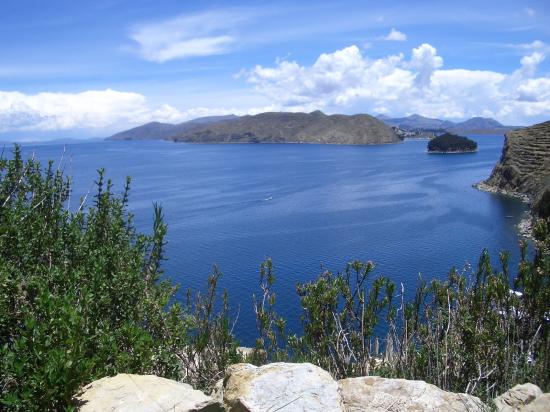



Lake Titicaca, Copacabana bay[/center]
Bolivia: 15 Years After the Cochabamba Water Revolt, Echoes in New Cases of Corporate Abuse
Bolivia: 15 Years After the Cochabamba Water Revolt, Echoes in New Cases of Corporate Abuse
Written by Philippa de Boissière
Monday, 27 April 2015 21:13

Fifteen years ago this month the people of Cochabamba, Bolivia were victorious in their now-famous showdown with one of the most powerful multinational corporations in the world, in what has come to be known as the Cochabamba Water Revolt. The attempt by the US Engineering giant Bechtel to privatize the city’s water supply backfired spectacularly when the people of Cochabamba faced down government forces to kick the multinational out of the country and to reclaim their rights to one of the most basic human necessities on the planet.
For people the world over, this stunning popular victory over corporate hubris in the Andes not only continues to inspire hope that another world is indeed possible; it also shines an urgent light on three fundamentals in the ongoing wider battle against the abuses of corporate power in South America: how the road is paved to allow foreign corporations to seize control of the continent's forests, waters and territories; the damages they inflict when they get there; and how communities are fighting back against a deepening transnational assault on their resources and on their sovereignty.
For Bechtel, the road into Bolivia and its water systems was paved by Washington Consensus-inspired loan conditionalities. In the late 1990s the World Bank told Bolivia to privatize Cochabamba’s Water as a condition of further lending for water expansion. In 1999, the Bolivian government agreed and signed a lavish forty-year lease with a mysterious Bechtel subsidiary that wasted no time in hiking up the cost of water. Rates rose by 50% and sometimes by as much as double. The result for ordinary Cochabambinos was devastating, with many families being forced to choose between such basics as water or food. People from across the department responded with unified indignation, three times shutting down the entire city with blockades, marches, and general strikes. Despite heavy state repression that left one teenage boy dead and hundreds more injured, the people succeeded in kicking Bechtel out of the country, reclaiming their water supply and achieving a powerful victory that still resonates globally today.
Fast forward to South America 2015. These same fundamental themes of foreign corporate dominance and resistance are echoed across three current cases involving powerful European multinationals, profiled in a recent report, Corporate Conquistadors, from the Democracy Center, Corporate Europe Observatory and Transnational Institute. In Peru, Spanish Repsol is threatening not only the sovereignty but the very existence of local indigenous communities, as it pushes ever deeper into fragile Amazonian ecosystems in the insatiable quest to expand its reserves of oil and gas. To the south of Peru, in the region of Espinar, Swiss Commodities and Mining conglomerate Glencore Xstrata is bulldozing over human rights as local community members share testimonies of already scarce water supplies being destroyed by its twin mega mining projects, Tintaya and Antapaccay. Finally, Italo-Spanish energy giant Enel-Endesa is set to flood some 8,500 hectares of vitally important agricultural lands in Huila, Colombia where it is constructing a 400MW dam to generate cheap energy - either for export or to set in motion a new wave of mega mining and unconventional gas operations.
More:
http://upsidedownworld.org/main/bolivia-archives-31/5305-bolivia-15-years-after-the-cochabamba-water-revolt-echoes-in-new-cases-of-corporate-abuse
Profile Information
Member since: 2002Number of posts: 160,515
